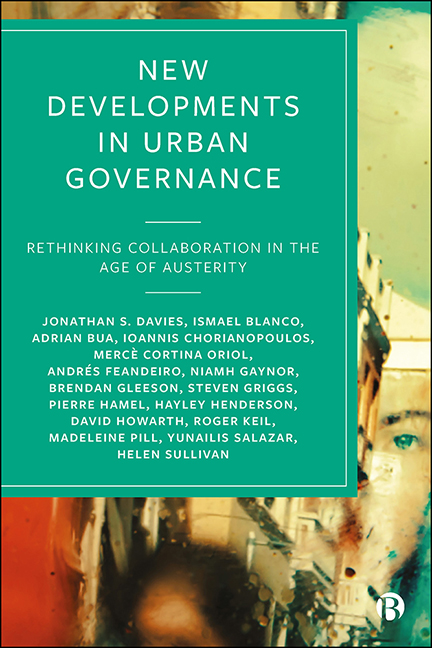Book contents
- Frontmatter
- Contents
- List of Figures and Tables
- Acknowledgements
- Introduction
- 1 Crisis and Austerity in Eight Cities: An Overview
- 2 Collaborative Governance After the Global Economic Crisis
- 3 Austerity Governance, Political Resistance and Urban Transformation
- 4 Rescaling through Austerity Governance
- 5 The Local State in Austerity Governance
- 6 Urban Cultural Diversity and Economic Migration in Austere Times
- 7 Conclusion
- Afterword: From Austerity to COVID-19 and Beyond
- Notes
- References
- Bibliography of Working Papers
- Index
4 - Rescaling through Austerity Governance
Published online by Cambridge University Press: 15 September 2022
- Frontmatter
- Contents
- List of Figures and Tables
- Acknowledgements
- Introduction
- 1 Crisis and Austerity in Eight Cities: An Overview
- 2 Collaborative Governance After the Global Economic Crisis
- 3 Austerity Governance, Political Resistance and Urban Transformation
- 4 Rescaling through Austerity Governance
- 5 The Local State in Austerity Governance
- 6 Urban Cultural Diversity and Economic Migration in Austere Times
- 7 Conclusion
- Afterword: From Austerity to COVID-19 and Beyond
- Notes
- References
- Bibliography of Working Papers
- Index
Summary
Introduction
The reality of austerity in our eight case study cities and elsewhere has been strongly shaped by a phenomenon, long studied by geographers and recognized across the social sciences as well as by practitioners in policy making, politics and activism: social, political and institutional spaces are structured through a hierarchy of spatial scales that is not pregiven but socially constructed. Emphasizing scale in this manner confirms an intuitive assumption we make on a daily basis – when we go to work from our home, or when we go on vacation – that ‘spaces across the world differ from one another’ (Brenner, 2009: 27). What might sound trivial, is an important marker in the way we understand the world around us. How, then, does scale matter specifically? We all know the concept of scale from the ways we use a map or a measuring tape. In this colloquial usage, we presuppose that there is a natural quality to the concept: we rely on its truth as given. If you use a map for a cycling trip, and its scale tells you that one centimetre on the map represents ten kilometres, you assume that if you plan a trip represented by five centimetres on the map, it means that the distance you will travel is, in fact, 50 kilometres in reality (never mind the hills and valleys).
While this ‘natural’ understanding of scale underlies its use in this chapter, we add to it the notion that scale in social life is, for the most part, not a given but socially constructed. Being part of the general vocabulary with which we seek to understand the uneven spatial development of modern society, scale reveals its true explanatory power when we realize that it is a plastic concept that is subject to interpretation and negotiation. When we use scale in this manner, we refer to ‘the vertical differentiation of social relations among, for instance, global, supranational, national, regional, urban and/or local levels’ (Brenner, 2009: 31). We say: scale is socially constructed and use participles such as ‘scaling’ or ‘rescaling’ to refer to the more or less intentional activity to shape this ‘vertical differentiation.’ Political decision makers and activists refer to the scale of government at which they want their action to count: the nation state, the region, the county, the municipality.
- Type
- Chapter
- Information
- New Developments in Urban GovernanceRethinking Collaboration in the Age of Austerity, pp. 67 - 90Publisher: Bristol University PressPrint publication year: 2022



